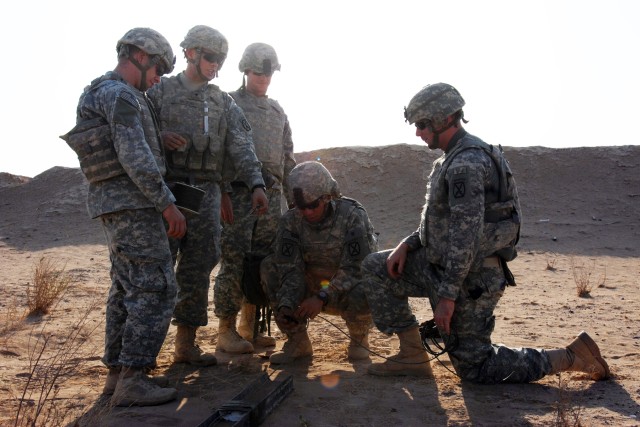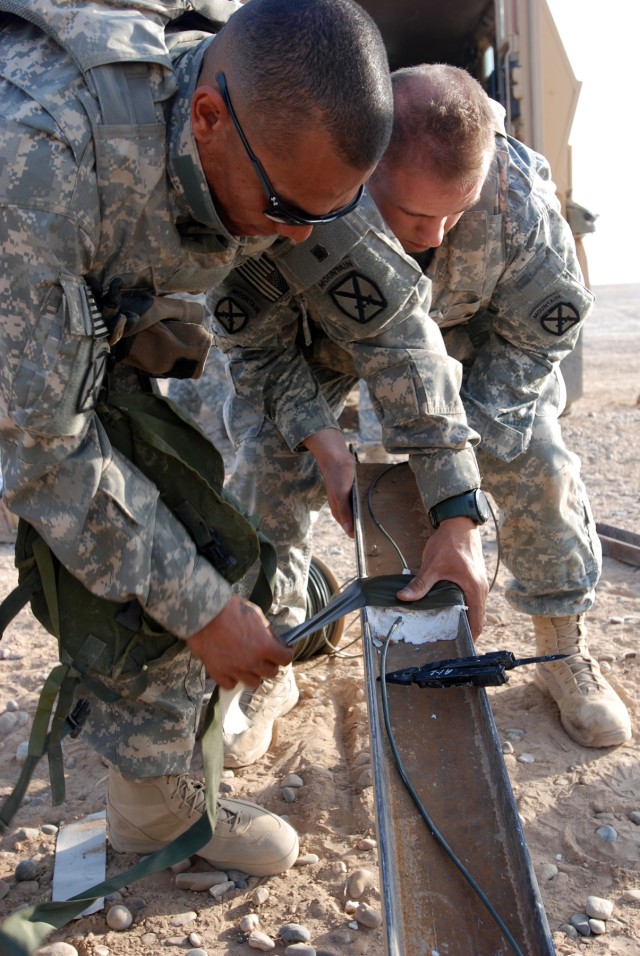CONTINGENCY OPERATING BASE SPEICHER, Iraq - Engineers from the Fox Company, 2nd Battalion, 10th Combat Aviation Brigade Pathfinders practiced advanced demolition techniques with their infantry teammates August 22 at Memorial Range here.
Two teams of one combat engineer "Sapper", one infantry noncommissioned officer and three lower enlisted infantrymen each used C-4 plastic explosive, detonation cord and fuse cord to wire and "cut" through pieces of steel in various sizes, shapes and thickness.
The hands-on training culminated three days of classes on advanced demolitions, including timber and steel cutting.
"The purpose was to train the engineers in advanced demolitions and to familiarize the infantrymen on explosives and the abilities of the engineers," said Staff Sgt. Neal Feldmann, company senior engineer. "We run frequent ranges to help keep the engineers proficient and teach the 11 Bravos [infantrymen] the basics of how demolitions work."
Feldmann said this type of training is rare for the lower-enlisted engineers, as advanced demolition techniques aren't usually taught within their military occupational specialty until the Basic Noncommissioned Officers course for staff sergeants; but it is even rarer for the infantrymen, since very few units have the combined arms capabilities the Pathfinders have.
"This is a great opportunity for the 11 Bravo's to get some cross training and understand the skills that the engineers bring to the fight," Feldmann said. "The training is good specifically for our unit because there are only four engineers in the company, and when doing demolitions we may be required to ask for assistance from the other Soldiers. This training provides them with some basic knowledge of the components of demolitions."
Since arriving in theater last October, Feldmann and his Pathfinder engineers have been called upon to destroy bunkers and construction materials, as well as reduce weapons caches and unexploded ordnance.
"Timber cutting is another useful tool for Pathfinder operations," Feldmann added. "As Pathfinders, we may be required to clear a landing zone for aircraft. If there are trees in the way, the timber cutting formulas and techniques could come into play. Having the 11Bs trained on these tasks would mean they would be able to assist the engineers in clearing these obstacles and allow the LZ to be established much quicker."
The engineers' role in the Pathfinder company doesn't end with performing detonations and teaching; as an integral part of maneuver operations, the Sappers are also expected to pick up infantry tactics, techniques and procedures while on mission. Rather than being a burden, Feldmann sees this as a combat multiplier increasing the capability of both branches to work together.
"The work the engineers do with the Pathfinders is significantly different from other engineer missions in the army," Feldmann explained. "With the global war on terror, the engineer units in the army mainly focus on route clearance missions; but this unit has allowed the engineers here to perform other missions, as well as conduct dismounted patrols and learn more about infantry tactics.
"Before GWOT, we would have one engineer squad assigned to support an infantry company, but generally there was no combined arms training - the infantry would go out and conduct their training, and the engineers would go out and conduct their own," Feldmann continued. "When it came time for the units to work together, there was a communication barrier. The infantry did not understand what the engineers could provide them, and the engineers were not familiar with the infantry tactics. Allowing us to work together has definitely closed that gap between the two."
Capt. Michael Keasler, Fox company executive officer, agreed, adding that having the engineers organic to their unit makes them a more effective force.
"Although our Sappers are not as skilled in the art of explosives as their EOD counterparts, they are task organized into our maneuver platoons," Keasler said. "This task organization prevents the company from having to halt operations and await the arrival of an EOD element, thereby allowing the company to reduce small caches of weapons and ammo, as well as reduce any obstacles or enemy positions without disrupting the flow of operations."
Combat engineers are not the only specialty MOS in the unique Pathfinder team. The company is also comprised of infantrymen, forward observers, medics and firefighters - a mix not seen in the Army outside of Special Operations and Ranger battalions.
It is this diversity that Keasler said allows the Pathfinders to execute such a wide range of missions anywhere in theater on short notice.
"The assignment of specialty MOS's, such as firefighters, Sappers and medics, provides the company with its own internal subject matter experts," he explained. "The fusion of these various skills and talents provides a source of knowledge and proficiency that cannot be found in any other Infantry unit in the Army. The proper utilization of these assets, combined with the inherent capabilities of air-ground integration, allows the company the flexibility to maintain the initiative when faced by the unpredictability of the modern battlefield."










Social Sharing